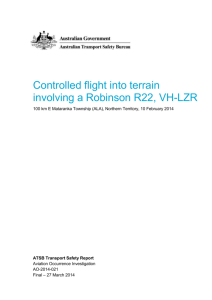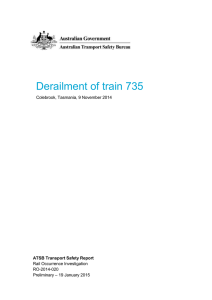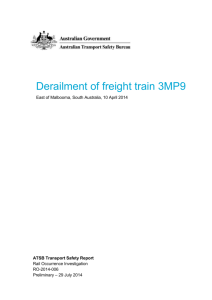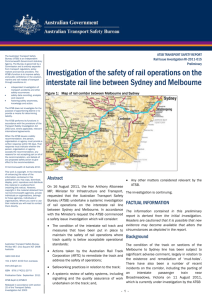DOCX - Australian Transport Safety Bureau
advertisement
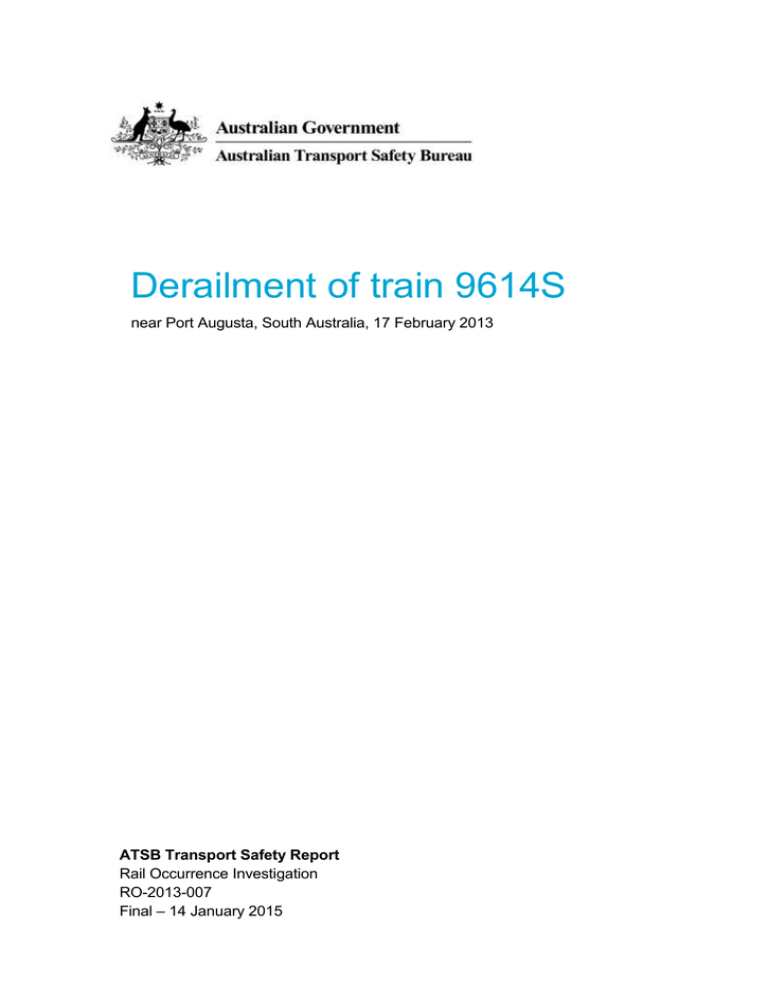
Derailment of train 9614S near Port Augusta, South Australia, 17 February 2013 ATSB Transport Safety Report Rail Occurrence Investigation RO-2013-007 Final – 14 January 2015 Source: Cover photo ATSB. Released in accordance with section 25 of the Transport Safety Investigation Act 2003 Publishing information Published by: Postal address: Office: Telephone: Facsimile: Email: Internet: Australian Transport Safety Bureau PO Box 967, Civic Square ACT 2608 62 Northbourne Avenue Canberra, Australian Capital Territory 2601 1800 020 616, from overseas +61 2 6257 4150 (24 hours) Accident and incident notification: 1800 011 034 (24 hours) 02 6247 3117, from overseas +61 2 6247 3117 atsbinfo@atsb.gov.au www.atsb.gov.au © Commonwealth of Australia 2014 Ownership of intellectual property rights in this publication Unless otherwise noted, copyright (and any other intellectual property rights, if any) in this publication is owned by the Commonwealth of Australia. Creative Commons licence With the exception of the Coat of Arms, ATSB logo, and photos and graphics in which a third party holds copyright, this publication is licensed under a Creative Commons Attribution 3.0 Australia licence. Creative Commons Attribution 3.0 Australia Licence is a standard form license agreement that allows you to copy, distribute, transmit and adapt this publication provided that you attribute the work. The ATSB’s preference is that you attribute this publication (and any material sourced from it) using the following wording: Source: Australian Transport Safety Bureau Copyright in material obtained from other agencies, private individuals or organisations, belongs to those agencies, individuals or organisations. Where you want to use their material you will need to contact them directly. Addendum Page Change Date Safety summary Derailed ore wagons What happened On 17 February 2013, ore train 9614S was departing Spencer Junction en route to Whyalla, South Australia. While the train was traversing 38A points at the northern end of Spencer Junction, the driver noticed a change in the train’s dynamic behaviour and immediately reduced the throttle. The train then quickly came to a stop due to the automatic application of the electronically controlled pneumatic train brake. Upon inspection of the train, the second driver discovered five ore wagons were derailed. What the ATSB found Source: ATSB The ATSB’s investigation found that the leading edge of the right hand 38A point blade was worn and damaged. The blade damage had created a ramping angle, allowing the lead wheel of the ore wagon to “ride up” the blade and derail. The derailed wheels then impacted and damaged the concrete sleepers, which ultimately failed to maintain track gauge and allowed further wagons to derail. During the derailment sequence, a rupture to the train’s electronic control pneumatic pipe initiated the application of the train brake. The ATSB found that the Australian Rail Track Corporation’s inspection and maintenance regime, following two similar derailments at the same location, had not been sufficient to identify and remediate the deteriorating condition of the 38A points, and ultimately contributed to the derailment. What's been done as a result In the months leading up to this derailment, Genesee Wyoming Australia (GWA) and the Australian Rail Track Corporation (ARTC) had agreed to a rail upgrade programme which included a new turnout incorporating 38A points, using 60 kg rail laid on concrete bearers. At the time of this derailment, a new turnout had been prepared, but had not yet been installed. Upgrade works have since been completed. Following installation of the upgraded infrastructure, more frequent monitoring for wear rates of the point blade(s) was undertaken. After several months of condition monitoring it became evident that track performance and wear rates could be managed as specified in the Code of Practice and the normal inspection schedule was reinstated. Safety message Track infrastructure owners and maintainers should consider the associated increase in wear on track infrastructure when there is an increase in the volume of rail vehicles being operated. The high dynamic forces that may be exerted from rail vehicles, specifically those that bear a heavy axle load, will accelerate the rate of wear on track infrastructure. In these circumstances, increased inspection and maintenance of track components should be considered until it can be established that resulting wear rates can be adequately managed in accordance with the established standards. Contents The occurrence ........................................................................................................................1 Context ......................................................................................................................................3 The Location 3 Train 9614S 3 Track infrastructure 4 Previous derailments at 38A points 4 Derailment – 17 February 2013 5 Maintenance system 6 Safety analysis .........................................................................................................................7 Track inspection and maintenance 7 Findings ....................................................................................................................................8 Contributing factors 8 Safety issues and actions ......................................................................................................9 Track maintenance 9 Safety issue description: 9 General details ...................................................................................................................... 11 Occurrence details 11 Train details 11 Sources and submissions .................................................................................................. 12 Sources of information 12 References 12 Submissions 12 Australian Transport Safety Bureau .................................................................................. 13 Purpose of safety investigations 13 Developing safety action 13 ATSB – RO-2013-007 The occurrence At 19391 on 17 February 2013, Genesee Wyoming Australia (GWA) ore train 9614S arrived at Spencer Junction, South Australia, on a return trip to Whyalla from Wirrida (about 137 km north of Tarcoola). Since there was no track available for south bound trains to travel directly to Whyalla via Spencer Junction, train 9614S was required to enter the marshalling yard before reversing direction to continue its journey towards Whyalla via 38A points (Figure 1). Figure 1: The path of train 9614S at Spencer Junction, South Australia Source: Australian Transport Safety Bureau Upon arrival at Spencer Junction, the train crew handed control to the Whyalla crew and retired to the crew van. The Whyalla crew were then driven to the other end of the train2 by car, where they set up the train’s Electronically Controlled Pneumatic (ECP) brake system3. A full continuity test4 was conducted and the driver contacted the ARTC Network Control to gain authority for transit from Spencer Junction to Whyalla. Meanwhile, the car driver relocated to a position at the lead of the train adjacent to the locomotives (approximately 150 m from 38A points), to carry out a roll-by5 inspection. At 2015, the crew received authority to travel to Whyalla and train 9614S commenced departure, traversing 38A points and onto the main line towards Whyalla. The driver gradually increased the train speed to 12 km/h, well within the maximum allowable speed limit of 15 km/h. At about 2020, the driver noticed a change in the dynamic behaviour of the train and made comment to the co-driver that the train felt heavier and noticed a loss of momentum. He then felt the train surge forward and recognised this movement as similar to the locomotives pushing from the rear of the train consist. Concerned about the erratic dynamic behaviour, he moved the throttle to the idle position and noted that the train rapidly came to a stop. At about the same time, an initiation of the train’s ECP brake system occurred, along with the illumination of warning lights and the sounding of alarms within the locomotive cab. The co-driver also saw that a large amount of dust had risen about half way back along the train. 1 2 3 4 5 The 24 hour clock is used in this report to describe the local time of day, Central Daylight-saving Time (CDT) Train 9614S was configured with four locomotives, two positioned at either end of the train consist. Electronically Controlled Pneumatic brakes – a system whereby the release and application of the train’s airbrake is communicated by an electric signal allowing a simultaneous response of the brake throughout the train. An air brake examination that confirms the train crew has control of the train by testing that there is brake pipe pressure throughout the train. A visual inspection of a train (while it is moving) to identify equipment, loading security or other defects/failures. ›1‹ ATSB – RO-2013-007 A series of radio communications then took place between the car driver conducting the roll-by inspection and the train crew. The car driver went to investigate and noted that a number of wagons had derailed around 38A points. He immediately contacted the GWA yard office while the train crew contacted GWA transport control to report the derailment. The train crew then contacted the ARTC Network Control, reported the derailment and cancelled the train authority. Both the train crew and the car driver began assessing the number of wagons that had derailed and inspecting the damage. In total, five 2-unit6 wagons had derailed and about 100 m of track, including 38A points, had been damaged (Figure 2). The rail network at Port Augusta was closed as a result of the derailment and all traffic movements through the immediate area were suspended. Figure 2: Derailment Inspection at Spencer Junction, Port Augusta, South Australia Source: Australian Transport Safety Bureau The derailment caused significant damage to the Whyalla mainline and minor damage to the EastWest mainline and the connected points. Repairs began at 1130 on 18 February 2013, and at 1916 that same day, the area was reopened for traffic. On 25 February 2013, a new turnout which comprised of 60 kg rail laid on concrete bearers was installed to replace the repaired turnout. 6 A wagon consisting of two permanently coupled platforms, each platform independently supported on a pair of bogies. ›2‹ ATSB – RO-2013-007 Context The Location Spencer Junction is a rail junction and marshalling yard located at the 95.2 km mark7 in Port Augusta, South Australia. Spencer Junction yard is owned and operated by GWA and provides a marshalling point for trains traversing the interstate rail network. It consists of a north and south entry/exit point and a number of marshalling roads which are used to make up or reorganise train consists. The northern end of Spencer Junction provides access to the Perth and Whyalla mainlines, with the southern end providing access to the mainline to Adelaide. The track arrangement at the northern end of the yard (including 38/38A points) was commonly referred to as the Whyalla crossover. All rail traffic entering or departing Spencer Junction yard from the north traverse these points. The Australian Rail Track Corporation (ARTC) are the owner/operator of the crossover and control all rail traffic movements from their Network Control Centre, located at Mile End in South Australia. At the time of this occurrence, GWA had recently completed an upgrade program within the marshalling yard. This upgrade included replacement of the existing 47 kg rail with new 60 kg rail. Prior to the derailment of train 9614S, the ARTC had assembled and placed a complete set of 60 kg rated points had been alongside the track ready to be installed as a replacement for the existing 38A points. Weather conditions At 2000 on 17 February 2013, the recorded temperature at Port Augusta was 31.3C with the wind from the south-southeast at 19 km/h. There was no evidence to suggest that weather or climatic conditions had contributed to the derailment. Train 9614S Train 9614S was operated by GWA and was carrying iron ore from Wirrida to Whyalla for Arrium Mining and Materials Pty Ltd. The train consisted of 78, PHAY 2-unit bottom discharge ore wagons, with two GWA class locomotives at the head end and two GWA class locomotives at the rear of the consist. The train had a total length of 1,692 m and a mass of 14,463 tonnes. Motive power and braking on train 9614S was delivered via Distributed Power Units (DPU) which allowed the locomotive at the head end to transmit driver inputs to the rear locomotive set. The train was fitted with an ECP brake system which offered improved performance compared to traditional pneumatic (compressed air) brake systems. The day before the derailment, a test of the train brakes during its outward journey to Wirrida (as train 6913), showed that the brakes were functioning properly. Onsite inspections indicated that wagon PHAY 1058A was the first wagon to derail. Inspection of this wagon and measurements taken by ATSB investigators showed that the all the wheels on each of the derailed wagons were within the design and safe operational specifications described in the rolling stock standard8. The ATSB found no evidence to suggest that rolling stock condition had contributed to the occurrence. 7 8 Distance measured from 0.0 km reference point located at Coonamia, South Australia. Australian Standard AS7514 Railway rolling stock – Wheels – Part 2 ›3‹ ATSB – RO-2013-007 Train crew Both Whyalla train crew were assessed medically fit and had practical experience in operating various types of locomotives and trains on the rail network within South Australia. The driver of train 9614S had 33 years’ experience as a train driver and had operated the Whyalla to Wirrida train on multiple occasions in the months prior to the occurrence. The co-driver had over 20 years’ experience in the rail industry. In August 2012, both the driver and co-driver completed their training in Wired Distributive Power9 and ECP train braking systems. The two competencies provided the drivers with the qualifications and skills to operate the locomotive configuration and brake system fitted to train 9614S. The available evidence indicates that train 9614S was managed in a manner that was consistent with normal driving practices. On that basis, train handling was excluded as a factor that may have contributed to this occurrence. Track infrastructure In December 2012, GWA began transporting iron ore from Wirrida to Whyalla. The average wagon axle weight10 of the loaded trains was 22 t. This was at the higher end of the axle loads operating on that part of the rail network. As axle loads and traffic volumes increase, stresses on infrastructure (such as the Whyalla crossover, including 38A points) also increase. In some cases, this can result in increased wear rates, requiring the consideration of increased inspection and maintenance regimes, or the installation of upgraded infrastructure. Previous derailments at 38A points There had been two previous derailments at 38A points in the six weeks prior to the derailment on 17 February 2013. Derailment – 8 January 2013 On 8 January 2013, ARTC staff attended Spencer Junction as part of their routine maintenance programme. While onsite, the Works Group Manager (manager) inspected the Whyalla crossover and noticed damage to 38A points. The manager advised that the points had suffered significant damage as a result of a transient derailment event, where the wheel of a wagon had ‘dropped’ in between the left hand blade and stock rail of 38A points, and then re–railed at the heel block (Figure 3). The derailment had not been reported by any of the train operators who utilise Spencer Junction, and as such it could not be established which train was involved. The manager surmised that the derailment may have resulted from a number of factors, including wear to the point blade at 38A points, and/or a suspect wheel11. It was evident that only one wheel had derailed, but without knowledge of what train was involved, the manager was unable to identify the wagon and wheel-set involved. The manager and his maintenance crew conducted works to temporarily rectify some of the damage sustained and faults identified. Records indicate that this work included the removal of the damaged left hand point blade and the fitting of a new blade assembly. The manager also recommended that the entire turnout be upgraded concurrently with the yard upgrade program which was already underway. 9 10 11 The placing of additional locomotives at intermediate points in the middle and/or rear of the train, remotely controlled from the leading locomotive, to allow longer trains where operational considerations or economics require it. Distributed power thus describes the physical distribution throughout the length of a train of separate motive power groups. Such 'groups' may be single units or multiple consists. The weight force exerted on the rails by the two wheels on any axle of a vehicle when stationary on level track. Term used by the ARTC to describe an unspecified defect within a rolling stock wheel set. ›4‹ ATSB – RO-2013-007 Figure 3: Wheel path over 38A points, Whyalla crossover, Spencer Junction Source: VAE Australia; annotated by ATSB Derailment – 12 January 2013 On 12 January 2013, terminal operators from Pacific National reported a derailment of a wagon at 38A points within Spencer Junction. Train 4611S was heading out of the yard along the Whyalla mainline when one wheel derailed, dropped between the left hand blade and the stock rail, and then re-railed at the heel pivot plate. The manager once again attended and conducted an inspection of the points. In his report, the manager assessed the ‘tightness’ of the rail curvature, weight of the train, bearer condition and wear to the right hand stock rail as factors contributing to the derailment. However, unlike the previous derailment on 8 January 2013, the manager surmised that as only one wheel had derailed, the derailment may have also been due to a bogie not being able to rotate sufficiently to negotiate the turnout geometry. The manager and his maintenance crew went about making further repairs to 38A points, and to ensure the rail would hold gauge12, replaced every third turnout bearer and fitted tie bars13. The entire turnout was identified as a ‘weak link’ within the system, and consistent with previous recommendations, the manager restated that the entire turnout required upgrading from 47 kg/m to 60 kg/m components. Derailment – 17 February 2013 When points are set to the normal or reverse position, one point blade should be housed against a stock rail. A wheel traveling along the stock rail will encounter the point blade both laterally and vertically. With conventional points, the blade tip must be positioned and shaped so that the wheel flange will freely travel past without striking or climbing the tip. On a worn point blade, a wheel may make contact further along the blade and not at the tip. Following this occurrence, a post-derailment inspection of 38A points by ATSB investigators identified a slight misalignment through the turnout, and observed that 290 mm of the leading 12 13 The distance between the inside running faces of the two rails, measured between two points 16 mm below the top of the rail heads. A rod used between rails of tracks to maintain gauge where other means are not appropriate. ›5‹ ATSB – RO-2013-007 edge of the right point blade was worn and damaged. The tip of the blade showed signs of plastic deformation (rail flow) and tearing damage from wheel flanges that had been attacking it. This wear resulted in wheels encountering the blade beyond the tip, where the blade head was quite wide. This created a ramping angle, where a wheel could ride up and over the blade rather than following the set route. Metal filings were also found near the area of wear on the point blade (Figure 4). These filings further indicated that wagon movements through 38A points were tracking hard against the right hand rail and the point blade. The force of the wheels tracking against the point blade would accelerate wear, causing further damage and degradation. Figure 4: 38A Points, Whyalla crossover, Spencer Junction SA Source: Australian Transport Safety Bureau It is likely that the curvature of the turnout, including the slight track misalignment, provided sufficient lateral force that the right side wheel on the lead bogie of wagon PHAY 1058A was forced up against the damaged point blade and subsequently rode up and over the head of the rail. It was evident that the derailed wheels then impacted the concrete sleepers, which ultimately failed to maintain track gauge and allowed further wagons to derail. Maintenance system Track infrastructure deteriorates over time as the result of use, climatic conditions and other factors. As such, periodic inspection and maintenance is required, to ensure that infrastructure condition stays at or above a defined limit or state that is appropriate for the operating requirements. The ARTC was responsible for the ongoing maintenance and serviceability of the rail network which adjoined Spencer Junction Yard. To maintain control of the maintenance process quality, the ARTC implemented and continually referred to the ARTC Engineering (Track & Civil) Code of Practice (The Code of Practice). The Code of Practice specified standards for infrastructure inspection and condition assessment, together with the action to be taken for defined defects as they are identified. ›6‹ ATSB – RO-2013-007 Safety analysis Track inspection and maintenance The ARTC Code of Practice14 describes the parameters and classification for assessing the damage to a point blade (Figure 5). Under this regime, point blade damage over a length of greater than 200 mm (as observed on 38A points) was classified as an A1 defect. The maintenance response defined for an A1 defect required a temporary speed restriction of 10 km/h under the guidance of a pilot, or for the defect to be repaired prior to the passage of the next train. Figure 5: 38A Points, Switch Tip Measurement Source: ARTC annotated by Australian Transport Safety Bureau It was evident that the damage to the right hand 38A point blade had resulted from factors that had existed for some time, such as tight turnout curvature, slight track misalignment and increased traffic. Records indicate that the condition of the blade six weeks earlier, when two derailments had occurred within four days of each other, was similar to the condition observed following the derailment on 17 February 2013. After the derailment on 8 January 2013, the ARTC had replaced the right hand blade on 38A points. However, evidence suggests that the blade continued to experience accelerated wear as wheels forcefully encountered the blade tip. After the derailment on 12 January 2013, records indicated that the left hand blade was also replaced (due to derailment damage), along with the replacement of every third bearer to stabilise the turnout. Despite replacement of both switch blades and the stabilisation works, the derailment of train 9614S about 1 month later was evidence that the rectification works had not effectively addressed all of the existing turnout issues. While the ARTC had approved and scheduled an upgrade of 38A points to a 60 kg/m turnout, it was evident that the ongoing rate of wear was more aggressive than could be managed under the existing maintenance inspection schedule. The accelerated wear was visible and identifiable, but there was no evidence that the ARTC’s inspection and maintenance regime had been adjusted sufficiently to monitor and manage the condition of 38A points at Spencer Junction, before the deterioration contributed to a further derailment. 14 ARTC Engineering (Track & Civil) Code of Practice Section 3 – Points and Crossings November 2011 ›7‹ ATSB – RO-2013-007 Findings From the evidence available, the following findings are made with respect to the derailment of train 9614S at Spencer Junction, Port Augusta, South Australia on 17 February 2013. These findings should not be read as apportioning blame or liability to any particular organisation or individual. Safety issues, or system problems, are highlighted in bold to emphasise their importance. A safety issue is an event or condition that increases safety risk and (a) can reasonably be regarded as having the potential to adversely affect the safety of future operations, and (b) is a characteristic of an organisation or a system, rather than a characteristic of a specific individual, or characteristic of an operating environment at a specific point in time. Contributing factors The leading edge of the right point blade of 38A points had worn and created a ramping angle which allowed wheel R1 of wagon PHAY 1058A to climb over the right stock rail and derail. Upgrade works for the 38A points and the associated turnout at Spencer Junction had been identified and scheduled, but not carried out before the derailment of train 9614S. The ARTC’s inspection and maintenance practices were ineffective at identifying and correcting the deteriorating condition of track infrastructure exhibiting accelerated wear, such as 38A points at Spencer Junction. [Safety issue] ›8‹ ATSB – RO-2013-007 Safety issues and actions The safety issues identified during this investigation are listed in the Findings and Safety issues and actions sections of this report. The Australian Transport Safety Bureau (ATSB) expects that all safety issues identified by the investigation should be addressed by the relevant organisation(s). In addressing those issues, the ATSB prefers to encourage relevant organisation(s) to proactively initiate safety action, rather than to issue formal safety recommendations or safety advisory notices. All of the directly involved parties were provided with a draft report and invited to provide submissions. As part of that process, each organisation was asked to communicate what safety actions, if any, they had carried out or were planning to carry out in relation to each safety issue relevant to their organisation. Track maintenance Number: RO-2013-007-SI-01 Issue owner: The Australian Rail Track Corporation Operation affected: Infrastructure Maintenance Who it affects: All rail safety workers and rolling stock operators Safety issue description: The ARTC’s inspection and maintenance practices were ineffective at identifying and correcting the deteriorating condition of track infrastructure exhibiting accelerated wear, such as 38A points at Spencer Junction. Proactive safety action taken by the Australian Rail Track Corporation Action number: RO-2013-007-NSA-075 The ARTC advised that works were planned for the upgrade of 38A points from 47 kg/m to 60 kg/m elements well prior to derailment of train 9614S, though installation did not occur until shortly after the derailment. Following the installation of the upgraded infrastructure, more frequent monitoring for wear rates of the point blade(s) was undertaken. After several months of condition monitoring it became evident that the track performance and wear rates could be managed as specified in the Code of Practice and the normal inspection schedule was reinstated. The ARTC acknowledged that the incident had identified several areas where safety outcomes could be enhanced: The need for remedial actions intended to return the asset to within the specified limits, (noting that the actions may consist of a number of tasks and application of a speed restriction) must be implemented in a timely manner and be both robust and sustainable. If necessary, increased targeted inspections to verify that the previously identified condition has been adequately addressed should be scheduled and the results documented. Strengthening of the existing internal interface between commercial, infrastructure and operational areas to ensure that initial consultation and ongoing dialogue on matters of mutual interest ›9‹ ATSB – RO-2013-007 Current status of the safety issue Issue status: Adequately addressed Justification: The ATSB is satisfied that the timely implementation of remedial action such as more frequent condition monitoring and rectification of potential deficiencies within infrastructure will better manage and reduce the likelihood of a similar occurrence in the future. › 10 ‹ ATSB – RO-2013-007 General details Occurrence details Date and time: 17 February 2013, 2020 CDT Occurrence category: Incident Primary occurrence type: Derailment Location: Spencer Junction, Port Augusta, South Australia Latitude: 32° 23.02’ S Longitude: 137° 46.01’ E Train details Train operator: Genesee Wyoming Australia Registration: 9614S Type of operation: Bulk Freight Haulage Persons on board: Crew – 4 Passengers – Nil Injuries: Crew – Nil Passengers – Nil Damage: Substantial › 11 ‹ ATSB – RO-2013-007 Sources and submissions Sources of information The sources of information during the investigation included: Genesee Wyoming Australia The Rail Industry Safety Standards Board (RISSB) The Australian Rail Track Corporation The drivers of train 9614S References Australian Standard AS7514 Railway rolling stock – Wheels – Part 2 Rail Industry Safety Standards Board (RISSB) Glossary of Railway Terminology – Guideline. V1.0 ARTC Engineering (Track & Civil) Code of Practice Section 3 – Points and Crossings November 2011 Submissions Under Part 4, Division 2 (Investigation Reports), Section 26 of the Transport Safety Investigation Act 2003, the ATSB may provide a draft report, on a confidential basis, to any person whom the ATSB considers appropriate. Section 26 (1) (a) of the Act allows a person receiving a draft report to make submissions to the ATSB about the draft report. A draft of this report was provided to: Genesee Wyoming Australia The Australian Rail Track Corporation The drivers of train 9614S The Office of the National Rail Safety Regulator Submissions were received from: Genesee Wyoming Australia The Australian Rail Track Corporation The drivers of train 9614S The Office of the National Rail Safety Regulator The submissions were reviewed and where considered appropriate, the text of the report was amended accordingly. › 12 ‹ ATSB – RO-2013-007 Australian Transport Safety Bureau The Australian Transport Safety Bureau (ATSB) is an independent Commonwealth Government statutory agency. The ATSB is governed by a Commission and is entirely separate from transport regulators, policy makers and service providers. The ATSB’s function is to improve safety and public confidence in the aviation, marine and rail modes of transport through excellence in: independent investigation of transport accidents and other safety occurrences; safety data recording, analysis and research; fostering safety awareness, knowledge and action. The ATSB is responsible for investigating accidents and other transport safety matters involving civil aviation, marine and rail operations in Australia that fall within Commonwealth jurisdiction, as well as participating in overseas investigations involving Australian registered aircraft and ships. A primary concern is the safety of commercial transport, with particular regard to fare-paying passenger operations. The ATSB performs its functions in accordance with the provisions of the Transport Safety Investigation Act 2003 and Regulations and, where applicable, relevant international agreements. Purpose of safety investigations The object of a safety investigation is to identify and reduce safety-related risk. ATSB investigations determine and communicate the safety factors related to the transport safety matter being investigated. It is not a function of the ATSB to apportion blame or determine liability. At the same time, an investigation report must include factual material of sufficient weight to support the analysis and findings. At all times the ATSB endeavours to balance the use of material that could imply adverse comment with the need to properly explain what happened, and why, in a fair and unbiased manner. Developing safety action Central to the ATSB’s investigation of transport safety matters is the early identification of safety issues in the transport environment. The ATSB prefers to encourage the relevant organisation(s) to initiate proactive safety action that addresses safety issues. Nevertheless, the ATSB may use its power to make a formal safety recommendation either during or at the end of an investigation, depending on the level of risk associated with a safety issue and the extent of corrective action undertaken by the relevant organisation. When safety recommendations are issued, they focus on clearly describing the safety issue of concern, rather than providing instructions or opinions on a preferred method of corrective action. As with equivalent overseas organisations, the ATSB has no power to enforce the implementation of its recommendations. It is a matter for the body to which an ATSB recommendation is directed to assess the costs and benefits of any particular means of addressing a safety issue. When the ATSB issues a safety recommendation to a person, organisation or agency, they must provide a written response within 90 days. That response must indicate whether they accept the recommendation, any reasons for not accepting part or all of the recommendation, and details of any proposed safety action to give effect to the recommendation. The ATSB can also issue safety advisory notices suggesting that an organisation or an industry sector consider a safety issue and take action where it believes it appropriate. There is no requirement for a formal response to an advisory notice, although the ATSB will publish any response it receives. › 13 ‹

